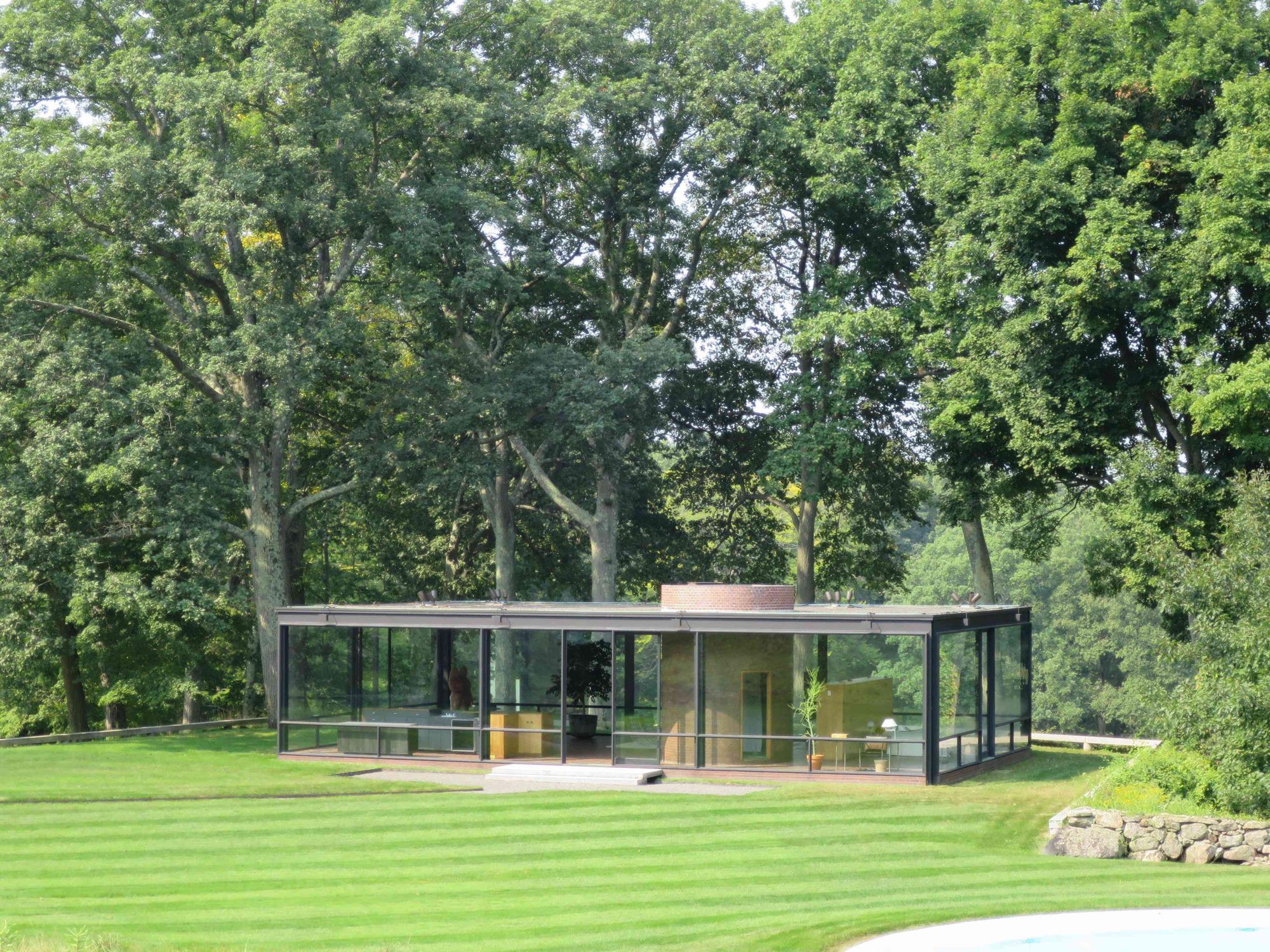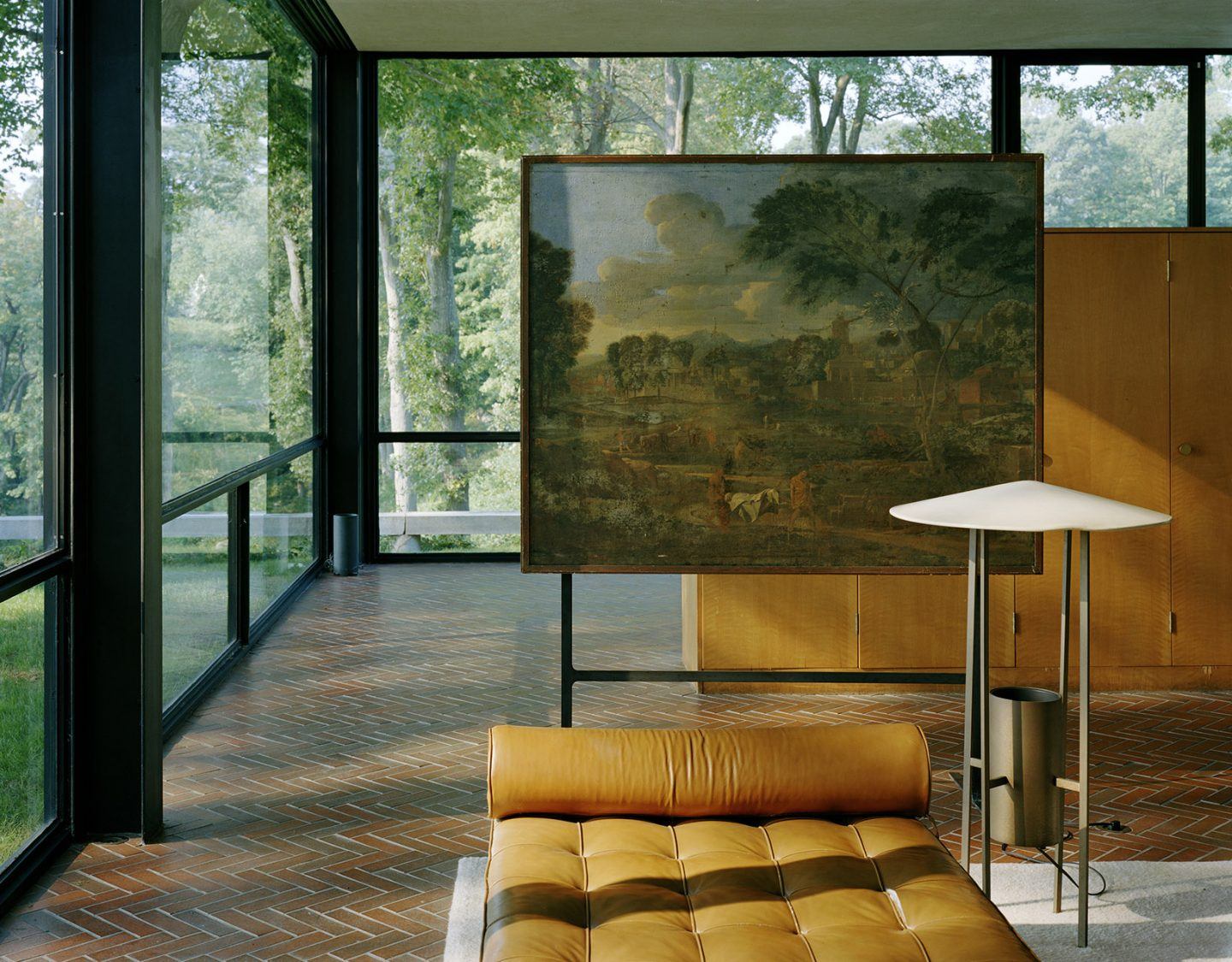Table Of Content

(…) It’s just a sort of a landscape in which I focused it on this knoll and this oak tree. The “uncanny,” as Freud emphasizes, however, can also be subtle and less striking—something, as he notes, like the fleeting reflection of oneself in a mirror, a sudden revelation of one’s own unwelcome image. In the case of the house of glass, perhaps its uncanniness derives less from its mimicking of the destroyed village than from its dually reflective and transparent surfaces, whose phantasmagoric effects create a montage of interior and exterior, of objects and sky. Johnson seemed to revel in these unhomelike appearances, through which he was at once present and absent in his own dwelling. She points to Johnson’s installation of a painting as a clue, perhaps, of Johnson’s own anxieties over his 1930s sympathies for Nazism. The painting, attributed to Poussin, the Burial of Phocion (1648), is displayed on an easel in the living area as if to connect the house to the picturesque landscape outside.
Locations in this article
Throughout the day, Gnomon/Wave will cast a moving shadow along and through the glass table where it rests. It is often asked why the Glass House is in New Canaan, Connecticut, a suburb in Fairfield County, located only about one hour from New York. The town became a magnet in the 1940s for several figures in architecture at Harvard. Marcel Breuer, Eliot Noyes, John Johansen and Landis Gores all came to New Canaan to build homes for their own use as well as for clients.
The Buildings And Grounds

This was his library as well, with some 1,400 volumes, only one of which isn't about art or architecture, but a work of fiction. The floor is also made of red brick laid out in a herringbone pattern and is raised ten inches off of ground level. The only other divisions in the house besides the bathroom are discreetly done with low cabinets and bookshelves, making the house a single open room. This provides ventilation from all four sides flowing through the house as well as ample lighting.
National Trust for Historic Preservation
The house is around 2,000 square feet and, aside from steel around its edges, has floor-to-ceiling glass around its entire exterior. Visitors standing in front of the property can see sunlight blazing through the rear walls of the home, seamlessly connecting the house with nature. Johnson famously quipped that he had the most beautiful and expensive wallpaper the world had ever known.
See Inside the Private Art Collection of Philip Johnson and David Whitney at the Glass House - Architectural Digest
See Inside the Private Art Collection of Philip Johnson and David Whitney at the Glass House.
Posted: Wed, 20 Jun 2018 07:00:00 GMT [source]
The most basic way to experience Johnson's signature work is the one-hour tour of the Glass House and the promontory it sits on. This involves a minimal amount of walking and costs $25 on Mondays and Fridays, and $30 on Saturdays. You'll see the house itself, plus the whirling swimming pool, and the spectacular view out the back windows of the pavilion in the pond below. But perhaps Johnson's most famous creation was his modestly-sized, 56' x 32' rectangle of a home in New Canaan, Connecticut, called Glass House.
On the Market: A Lake Champlain 'Glass House' by Philip Johnson - Boston magazine
On the Market: A Lake Champlain 'Glass House' by Philip Johnson.
Posted: Fri, 28 Apr 2023 07:00:00 GMT [source]
The Glass House has and will continue to engage in frank dialogue and open exchange about all aspects of its history, including Philip Johnson’s own history, and to work diligently to expand inclusivity in all aspects of our programming and operations. The Glass House, built between 1949 and 1995 by architect Philip Johnson, is a National Trust Historic Site located in New Canaan, Connecticut. Tours of the site are available in April through December and advance reservations are recommended. The Glass House features an open floor plan, with areas referred to as “rooms” despite the lack of walls, including a kitchen, dining room, living room, bedroom, hearth area, bathroom, and an entrance area. The furniture in the Glass House was sourced from Johnson’s New York apartment, designed by Mies van der Rohe in 1930, and includes the now-iconic daybed designed specifically for Johnson by Mies. According to Henry Urbach, director of the Glass House (now operated as a historic house museum by the National Trust for Historic Preservation), that rich sense of contradiction, even paradox, is part of the structure’s continuing appeal.

Brick House Restoration
Tucked out of sight in then rural Fairfield County, Johnson and his partner, curator David Whitney, purchased a five-acre parcel of land in 1945. By 1949, Johnson had built the Glass House on a promontory with views of the surrounding forest. Measuring 56 feet long, 32 feet wide, and 10.5 feet high, the open floor plan has no enclosed spaces except for a large brick cylinder to the right of the entrance, which extends slightly through the flat roof.
The focal point of the Glass House is the living room, with a rug defining the space and seating around a low table anchoring it. The placement of furniture is precise and contrasts with the ever-changing landscape outside. The bedroom, separated from the living room by built-in storage cabinets with walnut veneer, is the most private room in the house and contains a small desk. Philip Johnson sits in a corner of the Glass House in New Canaan, Connecticut, in 1998. The multiple reflections on the transparent glazed expanses seem to conceal as much as they reveal.
Philip Johnson's Glass House Opens to the Public
The installation aims to explore the unexpected opportunities offered by disparate building materials, such as glass, brick, and paper. Our most concise tour, focusing on The Glass House and its promontory, with a minimum of walking. Night, (1947) by sculptor Alberto Giacometti, was one of a handful of artworks that Philip Johnson displayed in the Glass House while he lived there. The plaster sculpture was granted a place of honor atop the central glass coffee table that Mies van der Rohe designed for Johnson. In the 1960s, Night began to shed its outer layer and was eventually sent to the artist’s studio for repair. Giacometti died before the work was conserved, and the sculpture was never returned.
The glass walls and other intriguing features of the dwelling inspired psychoanalyst Adele Tutter to go beyond the usual architectural analysis to a psychological one. Johnson would trudge across the field to his Studio in all seasons--he kept the grass uncut, because he liked the way the grassy hills rippled in the wind--and though the space is air-conditioned, a fireplace provides the only warmth in the winter. Like all of his buildings here, starting with Glass House, it feels as sculptural as much as a work of architecture.
Day is the first artist the Glass House has invited to reinterpret the building, originally intended as a visitor center and now used as a project space for contemporary art. Johnson’s style took a final turn with the New York City AT&T Building (1984; it was later sold and renamed). Designed with a top resembling a Chippendale cabinet, the building was considered by critics to be a landmark in the history of postmodern architecture. Johnson turned explicitly to the 18th century for his design of the Gerald D. Hines College of Architecture at the University of Houston (1983–85); it was based on unexecuted plans published by the French architect Claude-Nicolas Ledoux.
Since his early days visiting the Bauhaus, Johnson had been an admirer of Breuer’s with whom Johnson also studied while at Harvard. Breuer had joined a number of his former Bauhaus colleagues under Walter Gropius’s leadership at Harvard following their departures from Germany in the late 1930s. I found a great oak tree and I hung a whole design on the oak tree and the knoll because of this place.
The Glass House stylistically is a mixture of Mies van der Rohe, Malevich, the Parthenon, the English garden, the whole Romantic Movement, the asymmetry of the 19th century. In other words, all these things are mixed up in it but basically it is the last of the modern, in the sense of the historic way we treat modern architecture today, the simple cube. Since its completion in 1949, the building and decor have not strayed from their original design.
The Glass House or Johnson house, built in 1949 in New Canaan, Connecticut built atop a dramatic hill on a rolling 47-acre estate was designed by Philip Johnson as his own residence and is considered a masterpiece in the use of glass. It is now operated as a historic house museum by the National Trust for Historic Preservation. An early proponent of modern architecture who later went in various design directions, from postmodernism to later explorations of non-Euclidean geometry, Johnson was not easy to pigeonhole stylistically. What is undeniable is that Johnson would go on to build substantial projects worldwide and also became one of the central powerbrokers of architecture in America for much of the 20th Century.
In 1986, he bequeathed it all to the National Trust for Historic Preservation. Two years after Johnson died in 2005 (inside Glass House, by the way), the sprawling site was opened to the public and it has been hosting tours ever since. In New York city alone, Johnson's legacy includes the Seagram Building at 375 Park Avenue, the AT&T Building at 550 Madison Avenue, the Lipstick Building at 885 Third Avenue, and the New York State Theater (home to the New York City Ballet) at Lincoln Center. He was also responsible for the Sculpture Garden at the Museum of Modern Art, where he served as the first director of the architecture department in 1930, and to which he donated some 2,200 works from his personal art collection over the course of his lifetime.
On some nights the field opposite the gallery entrance was used for performances, or "happenings," by such luminaries as the Martha Graham Dance Company. Completed in 1949, the Glass House was the first design Johnson built on the property. The one-story house has a 32'x56' open floor plan enclosed in 18-feet-wide floor-to-ceiling sheets of glass between black steel piers and stock H-beams that anchored the glass in place. It is said that the brilliant mentor to Philip Johnson stormed out in fury because of what he interpreted as a lack of thought in the details of the house. Visit five significant houses designed by Philip Johnson in New Canaan, CT on an exclusive one day study tour in celebration of the 110th anniversary of Philip Johnson’s birth and the 10th anniversary of the opening of the Glass House to the public.


No comments:
Post a Comment